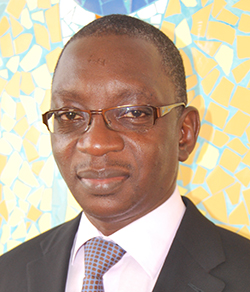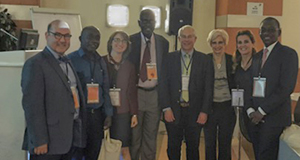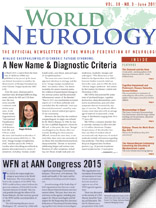By Gallo Diop

Gallo Diop
The first Turkish-African Meeting of Headache and Pain Management was held May 2-6 in Istanbul, Turkey. It was convened by the Turkish Headache Society and organized by Prof. Hayrunnisa Bolay from Gazi University, Ankara. There was major support from the Turkish International Cooperation Agency (TIKA). It was held under the auspices of and with support from the International Headache Society (IHS). In attendence was Alan Rapoport, president; three other board members of the IHS (Hayrunnisa Bolay, Peter Goadsby, Andy Charles); Dimos Mitsikostas, president of the European Headache Federation; Zaza Katsarava, vice president of the European Headache Federation; and Aksel Siva, president of Turkish Headache Society. This scientific neuro-event was attended by almost 70 senior and young neurologists from different African countries (Botsawana, Djibouti, Egypt, Ethiopia, Kenya, Morocco, Nigeria, Senegal, Sudan), Germany, Georgia, Greece, Denmark, U.K., U.S., and the hosting country Turkey, represented by headache experts from universities of Istanbul and of Gazi (Ankara). The key highlights were:
- To promote the cooperation and interactions among headache specialists from IHS, headache societies across African countries and Turkey
- Aim to educate young leaders and train clinicians to alleviate pain and increase quality of life of people with headache disorders in Pan Africa
- To learn more about the current conditions and requirements for headache in Africa
- To increase skills for and knowledge about headache and pain management
- Leading international faculty to teach about headache and pain
- Particularly useful for young neurologists, algologists, senior residents and other medical doctors who care for patients with headache and painful conditions
- Membership to IHS will be provided to participants without charge if they are from a country listed as one of the 100 poorest countries in the world.
The meeting covered a wide range of important topics related to headache and pain medicine. The first part of the event ran on the website and involved the theoretical reading of basic papers and live international webinars. The second part of the meeting brought together more than a dozen world-renowned headache and pain experts to teach and mentor the junior physicians from Africa and Turkey. Teaching lectures, interactive sessions, case-based learning and practical interventional courses took place in Istanbul during four days. Professors assistant, professors and residents from African universities took part in lectures, cases presentations and discussions.
Day 1
Day 1 was the opening with welcome statements from Bolay, trustee of IHS and convener of the meeting; Prof. Najib Kissani, neurologists at the of University of Marakesh, Morocco; Rapoport, president of International Headache Society from the University of California, Los Angeles; and Siva, president of Turkish Headache Society, from Istanbul. It was followed by lectures.

Attendees of the first Turkish African Headache and Pain Meeting with IHS staff.
Yohannes W. Woldeamanuel, trained in neurology in Ethiopia (2009-2013), is an IHS scholarship awardee and post-doctoral fellow at the Stanford Headache Program. He reported on ‘’Burden of Headache in Africa and Emerging Challenges.” Woldeamanuel emphasized that headache was the 13th cause of YLDs in 2010; migraine represents 15 percent of Africa’s DALYs. In Africa, it is noted a great number of seconday-type headaches from infectious disorders (WHO, 2011, Atlas of Headache Disorders and Resources in the World; Woldeamanuel, 2014, J. Neur. Sci., 342). He suggested collecting more population data with incidence and prevalence rates, prospective research to increase awareness about pain and headache, and more research about traditional management.
Prof. Kissani reported on ‘’Headache in Morroco.” Even if the ratio is better than many African
countries, there is still great lack of specialists for taking care of pain. Prevalence of migraine in Morocco is estimated to 13 percent. Eighteen percent of patients suffering from headache have at least visited one or many healers (Kissani et al, 2009). Results of research supported by ‘’Lifting the Burden: The Global Campaign to Reduce the Burden of Headache Worldwide” Initiative revealed that 85 percent of the 3,600 interviewed people reported more than one headache last year. About 22.5 percent of them suffered from chronic headaches: tension type (48 percent) and migraine (26 percent). Fifty percent used modern medications (55 percent paracetamol; 10 percent aspirin; cost: $22/month). (Some use of combinations also are reported). Ten percent reported consulting traditional healers.
Hellen Kariuki, professor of physiology at Nairobi University, reported on ‘’Natural Traditional Methods to Overcome Pain.” She reported about the dramatic and rapid change of Africans’ lifestyle. Plants are rich sources of pain management around the world. She described some plants that are used by local tribes as painkillers. She discussed how to benefit from these findings and local oportunities to concretely improve management of pain in developing countries.
Rachid Bezad, professor of gynecolgy (Morocco), discussed ‘’The Contribution of Morocco and Africa to Medicine” and described the health system in Morocco and the opportunities of training and cooperation offered by his country.
Days 2-4
Days 2-4 were dedicated to various lectures, cases presentations and practical courses (such as group learning with patients suffering from headaches and practical training in invasive analgesia techniques, peripheral nerve blocks, trigger point injection and acupuncture). Various thematic topics were developed during exciting lectures: classification and evaluation of headache; how to investigate headache patients in restructed resource-setting; choice of treatment options; migraine headache and its mechanisms and management; chronic daily headache and its neurobiology and differential diagnosis; history taking of headaches and pain by specialists; secondary headaches; headaches attributed to infections; women and headache; headache in children and adolescents; chronic pain disorders; and invasive treatment in headache and pain.

From left to right, Aksel Siva, Mustafa, Dr. Ozge, Pr Ndiaye; Alan Rapoport, Hayrunnisa Bolay, Dr. Uluduz and Gallo Diop.
The meeting was successful in all aspects: organization, scientifc program, and social and friendship environment.
This educational meeting was an excellent opportunity to learn about the diagnosis and management of headache and pain disorders, new developments in the science of headache medicine and the care of headache sufferers.
Through the meeting, everybody has learned more about the current conditions in and requirements for headache in Africa. The meeting will promote the cooperation and interactions among headache specialists from the IHS, various headache societies across African countries, Turkey and worldwide.
It was a contributive additional action for the vision of World Federation of Neurology to promote, via its Africa Initiative, training and exchanges as a leveraging opportunity for trainees and specialists continuing professional development in Africa. This meeting comes also as an additional contribution of Turkish Neurology Society in regard to this aim, because this country is already offering (over three years) two scholarships per year, for a month short-term training in neurology departments of Turkish universities for young African neurologists.
Next plans will aim to educate young leaders and increase skills for and knowledge about headache and pain management to alleviate pain and increase quality of life of people with headache disorders throughout Africa. A short- and long-term plan of action has been discussed and will increase the implication of Turkey, IHS and other specialties to fulfill training needs in Africa, in addition to their various contributions during the Regional Teaching Courses organized by European Academy of Neurology and WFN in Africa for 8 years. For more information, visit www.tahpm.org.
